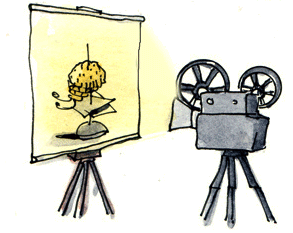Pitch perfect and pitch noir ... Miss Lumière takes us to Bill Cunningham: New York and Autoluminesence: Rowland S. Howard ... Documentaries and what they don't tell us
 The evidence is in - documentaries are the "new black" of the cinema world.
The evidence is in - documentaries are the "new black" of the cinema world.
Two very different examples of the genre currently screening make the case in brilliant style - Bill Cunningham: New York and Autoluminescence: Rowland S. Howard.
Both focus on an extraordinary individual of the artistic persuasion - one visual, the other musical - although the characters and the docos couldn't be more contrary.
Bill Cunningham is all about the joy of life and Rowland S. Howard is all about the sadness of life.
So powerful is each film's evocation of character and place - New York in Cunningham's case and Melbourne and Berlin in Howard's - that your reviewer came away believing both versions of the world simultaneously.
But first to the joy.
Bill Cunningham is one of New York's legendary eccentrics. He's been photographing street fashion and what passes for New York society for over fifty years.
His work On the Street and Evening Hours appears regularly in The New York Times and he never stops - running, crouching, photographing, editing, smiling.
At 82, he has a beatific face and attitude to everyone and everything.
All this is well captured on the run - or in Bill's case on his trusty bike - but it is the interviews with the man himself and his subjects, friends and colleagues that give the film its emotional heft and poignancy.
The same is true of Lynn-Maree Milburn and Richard Lowenstein's portrait of their friend Rowland S. Howard, a much-admired Melbourne post-punk/new wave/experimental songwriter and guitarist.
Both men are true originals, true to their own eccentricities and talents, because in a sense they have no other option.
Cunningham's eccentricities run to living a life of integrity - eschewing money, new clothes and free food and drink.
Howard also lived a life of artistic integrity, but sadly his eccentricities included a life-long addiction to heroin, as well as a penchant for emotional misery.
How each man makes art from their particularity is beautifully conveyed by both documentaries.
Richard Press, the director/interviewer in Bill Cunningham takes a gentle, probative approach to his subject, who at one exceedingly delicate moment, becomes painfully vulnerable.
It's difficult to watch and it gives the documentary another dimension, aside from the inspirational.
The same isn't quite true about Autoluminescent.
While it is clearly a much more skilful and poetically made documentary, it fails to penetrate the surface of Howard's self-declared sadness.
The interviews aren't uniformly good, with Nick Cave appearing to tread lightly.
This could be due to a lingering sense of coming second to Howard's obvious originality.
(Howard joined Cave's Boys Next Door and The Birthday Party in the late seventies and wrote one of the era's defining songs, Shivers, which Cave subsequently made his own.)
The documentary certainly captures the early times, with a lot of grainy black and white footage of grotty music venues in Melbourne and Berlin.
Miss Lumiere was there, inhaling smoke and other substances, so she can vouch for its grimy verisimilitude.
However, finally, we end up not knowing more about Howard than what he tells us.
With Cunningham, we begin to sense the things he doesn't tell us.
The difference is perfectly summed up in the two titles - Cunningham embraces the world, but Howard only saw his own bright reflection in it.
Miss Lumière